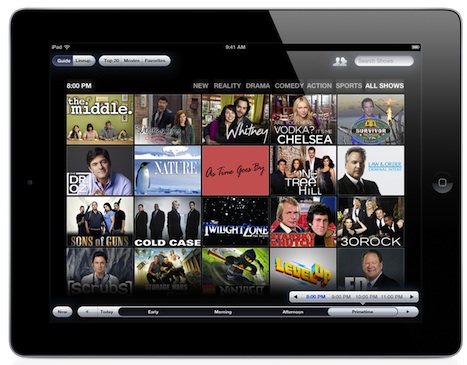
The social TV app yap.TV is launching Live Pulse, a button that informs users that live synced content is available while they are watching a show, the company announced today. Besides Live Pulse, the startup is also introducing a CMS that lets broadcasters and content owners manage their own second screen experience.
According to its co-founders, this is fairly unique in the second screen space. Yet it doesn’t mean that yap.TV doesn’t have competitors. As we reported, TV companion apps have mushroomed over the last few months, with players such as GetGlue, Miso, TVCheck, Umami.TV and Zeebox all fighting for eyeballs.
So what is it about yap.TV that caught Apple co-founder Steve Wozniak’s attention enough for him to come on board as an advisor? We decided to ask its SMO Shawn Cunningham a few questions about the company’s identity and its latest news.
AH: Can you tell us about yap.TV and its team?
Shawn Cunningham: I am one of the company’s three co-founders, together with Trevor Stout and Marius Seritan. We have all been doing this for a very long time. We are also particularly focused on interface design – we have great designers on board, and we are also very proud to have Steve Wozniak as one of our advisors.
As for the product itself, the best way to describe it is as a social TV guide. We want it to be the ultimate second screen experience for TV content consumption.
AH: How would you describe yap.TV’s priorities?
SC: We launched in early 2010, so we were early into the market. Compared to the players which later entered this space, we also had a very different view of what was required to succeed.

Our starting point was the worldwide hatred for the Guide button of our TV remotes. We knew that content discovery was going to be big, and we decided to pull data from traditional TV guides and turn it into a graphically pleasant experience. It is also interactive, and users can answer polls and chat with their friends while watching TV.
As a matter of fact, we understood very early that our approach had to be social; we get our best TV recommendations from our friends, and we talk about TV programs around the watercooler. Of course, this also happens on social networks, and we worked on enhancing this experience – our app is integrated with Twitter’s Firehose and Facebook’s Open Graph to pull, aggregate and filter the best content about each show.
AH: There are many second screen apps now. What differentiates yap.TV from its competition?
SC: Besides our customers, we are also serving enterprise partners – and as far as I know, our competitors aren’t. Our view is that networks are interested in this space, but don’t always have the internal team to handle a second screen app. We want to provide them with “social TV as a service” – they can use our platform to reach viewers in a very flexible way. For instance, they can modify the app’s experience in real-time and very easily.
Besides this difference, we also avoided some mistakes that other second screen startups made. For instance, we knew early on that check-in was only a feature, not the product in itself [see our article about Miso’s pivot]. We feel the same about audio recognition – it’s a nice tool, but we don’t think users should see it [see our article about Shazam and American Idol].
AH: What’s the link between the app you developed for USA Network and your CRM for broadcasters.
SC: The iOS app we developed for USA Network was our first deal with a big network. What was interesting is that we managed to convince them that a network-wide app was the best way to keep in touch with their viewers.
The integration with yap.TV was also very important, because there’s no point in denying that Americans watch several channels. On the other hand, we are hopeful that our app will get people to tune in more – the visual experience makes content discovery much easier and serves as an incentive to watch new shows.

AH: More recently, you have also launched an app around Jennifer Lopez’ and Marc Anthony’s latest reality show, ‘¡Q’VIVA!‘. How did it happen and what’s new about it?
SC: I call it our ‘American Idol’ moment – because we had to pitch our idea to Simon Fuller in person, since his company XIX Entertainment is producing the show! He really understood what we were offering, which is a truly integrated experience – we are convinced that the second screen will become integral to the first screen.
That’s also the approach we used with ¡Q’Viva! – we worked very closely with the show’s editors, to make sure that the app’s content was in sync with the show and with its ads. For instance, if you see a short edited performance on TV, you also get the option to see the long-version performance on your mobile device.

Another challenge was to develop our app in three languages at the same time, since the show is filmed and broadcast across Latin America and the US.
AH: I have also noticed that this app was available on Blackberry devices. Does it have to do with the specificities of the Latin American market?
SC: Yes, our decision to make the app available on BlackBerry handsets and on the PlayBook tablet was driven by the fact that these devices are popular in Latin America. Our goal is for yap.TV to be available everywhere our users are, and we will adopt the same approach in other markets.
AH: Do you have plans for other regions?
SC: We want yap.TV to be global, which is another difference with our competitors, as most of them are focusing on one single region. After Latin America, we will very soon be entering Europe, followed by Asia. Ultimately, our app will be available wherever we can find good guide data to build on – we have deals in place with the two main TV guide data providers, Rovi and TNS.
AH: What’s yap.TV’s long term goal?
SC: Think about YouTube and how we have all come to automatically associate it with UGC. We want yap.TV to become the same for social TV: the default destination users all around the world think about when they are looking for second screen content.
➤ yap.TV, via the App Store
Get the TNW newsletter
Get the most important tech news in your inbox each week.




